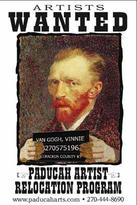Paducah: Soho of the south?
A friend sends along a couple of Chicago Tribune articles (free registration required) about Paducah, a small city (27,000) on the Ohio River in western Kentucky. The city is providing incentives to encourage artists to relocate in and revitalize a struggling older neighborhood. So far they've spent $600,000 on direct incentives, are spending another $1.2 million on infrastructure improvements in the neighborhood, and they claim to have seen $7 million in private investment by the artists themselves.
(Here's a link to another article about Paducah on the National Trust for Historic Preservation's website which doesn't require registration.)
The inspiration was Paducah's Artist Relocation Program, which has exerted the same magnetic pull on others who've dreamed of living, working and, most importantly, owning in a neighborhood of like-minded residents. In 2 1/2 years, nearly 40 people have moved here to transform a beat-up area of homes known as Lower Town into a blossoming art colony.The newcomers have come from as far away as San Francisco and Massachusetts to take advantage of incentives making it easy for them to buy old houses -- at dirt-cheap prices -- to turn into studios and galleries. Almost to a person, these painters, sculptors, muralists, printmakers and jewelers say they never, ever pictured themselves moving to Kentucky.
How does the program work?
The houses Paducah offers have been claimed by the city for back taxes or purchased from owners more than happy to unload, in a few cases, code-violating structures. In some instances, the city relocated displaced Lower Town residents."We've done it a variety of ways, and we've actually just given property away," said Paducah Planning Director Tom Barnett. "We've also bought homes at market price and sold them for less, but it's worth it just to get the neighborhood revitalized. We're willing to talk. The long-term impact can't help but be good."
What kind of people are taking advantage of the program?
The prospect of owning a home and workplace has been a powerful attraction for these artists, noted program founder and painter/printmaker Mark Barone. The incentives, plus the town's relatively low cost of living, inspired some newcomers to plunge full time into their art."Bill Renzulli is an example of that," Barone said. "He was a medical doctor [in Maryland] by training but is a serious painter who had been in and out of it as a profession for years. Our program gave him the confidence and opportunity to return to it full time. He'd heard about us, came to visit in the winter -- said he wanted to see the town at its worst -- and called us a couple days later to say he's coming." ...
"To be honest, I was pretty skeptical of the whole [program] at first," said Wally Bateman, bank president. "My fear was that we were going to have this Volkswagen bus pull up with people who were simply penniless. But the applicants have turned out to be absolutely wonderful, wonderful additions. Their credit's been excellent and, in some cases, they brought cash in addition to artistic skills."
City officials estimate the artist relocation program pumped an extra $12 million to $15 million overall into the local economy last year, and it's safe to assume much of it went to local contractors and tradespeople. The Lower Town streets are alive with construction trucks and vehicles making deliveries to sounds of pounding hammers and whining electric saws and drills....
"What you can't measure is how this adds to the town's vitality in ways other than economics," [Paducah mayor] Paxton said. "It's brought a new type of person into our community with lots of energy and creativity. I've made it a point to get to know them. These are people who volunteer and serve on boards. Cities our size [27,000] are dying for this right now."
And here's another wonderful idea: Paducah has two old downtown movie theatres (built in 1911 and 1927 respectively) that were given to the city. The city will give them away to someone with a solid plan for bringing them back to life, and will provide architectural fees, free wiring, discounts on materials, and financing from a group of local banks.
Wouldn't it have been wonderful to have done that in Tulsa? This illustrates another key to downtown revitalization -- it helps if your city was a neglected backwater during the Age of Urban Renewal and Ugly Architecture, when graceful old buildings were demolished to make space for concrete boxes. During this redevelopment frenzy, no one cared enough to remake the backwater towns. It was all right for buildings to sit vacant for a few decades -- there was no better and higher use available. The homes and theatres and downtown retail blocks were there waiting to be rediscovered and restored as more people began to recognize and appreciate the treasures in their own towns.
The National Trust for Historic Preservation's Main Street program had a lot to do with helping people see how older buildings could be turned into a source of civic pride.
During the same age of ugliness, Tulsa had piles of money, a demand for ever taller buildings, and shortsighted civic and business leaders with no appreciation for beauty and history. Despite a growing number of Tulsans who are investing their own money and sweat into restoring, renovating, and adaptively reusing historic homes and buildings, it seems (as you will see in a forthcoming item) that we still have some local leaders who regard history as an obstacle rather than an opportunity.
It appears that Paducah is a city blessed with farsighted civic and business leaders who see beauty and history as a key to future prosperity. Here are links to the Paducah Artist Relocation Program website and the Lower Town Arts Community.
